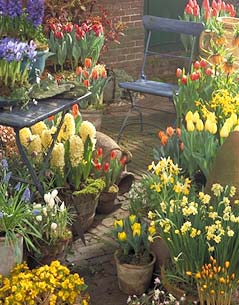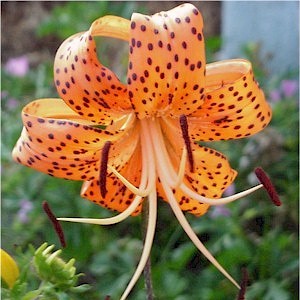| Planting
bulbs is easy. You can break a serious
sweat, however, if you're doing mass plantings.
Either way, the two most important points
that you should know about planting a
bulb are:
 |
|
1 - Set the bulb
at the correct depth.
2 - Make sure you place the bulb
right side up in the hole.
|
The
chart in Figure 1 shows the recommended
planting depths and proper positioning
for common bulb types. As a general rule,
most bulbs should be planted at a depth
equal to three times their diameter. For
example, plant a 2-inch (5 cm) bulb 6
inches (15 cm) deep. Remnants of roots
on the bottom of the bulb should tell
you which side of the bulb points down.
If you see no sign of root remnants, plant
the bulb so that the most pointed, narrow
part points up. If you have any doubts,
ask your local nursery.
Figure 1: Use this bulb-planting
depth chart as a guide when you plant
your own bulbs.

NOTE: If
you have heavy clay soil, and many do
in Zone 8, plant at one-half the recommended
depth. The bulb
won't have to expend as much energy struggling
through the dense clay.
There are two types of
bulbs:
 |
Spring
Bulbs such as Daffodils
are planted in Fall/Winter and will
bloom in Spring. |
 |
Summer
Bulbs such as Hybrid
Lilies are planted in Spring and will
bloom in Summer |
You can plant bulbs individually
by using a hand trowel or bulb planter.
If you are planting many bulbs, dig one
big trench or hole and place the bulbs
in the bottom.
Most bulbs require well-drained
soil. (Bulbs can rot in soggy, overly
wet ground.) Before planting your bulbs,
mix a slow-release, complete fertilizer
into the soil in the bottom of the hole,
then add a little more soil so that the
bulb itself doesn't come in contact with
the fertilizer granules. You can find
appropriate bulb fertilizers in nurseries
and garden centers. After planting the
bulbs, water them thoroughly.
What's your style?
The planting method and type of bulb you
choose can depend on the design style
you want to achieve: natural or formal.
Naturalizing refers to the ability of
some bulbs to come back year after year.
In Zone 8, Daffodils are perfect for naturalizing
in the edges of islands or woodland borders.
In naturalistic design, you do your best
to imitate a natural planting for a particular
type bulb, and you choose bulbs that go
on to naturalize on their own, thereby
making the planting look more natural
year after year. We like to grab a bag
of Daffodils and as we walk along the
edge of an island or woodland border drop
three bulbs at a time and plant them where
they land!
In
formal design, it's unlikely you'd need
or want bulbs that come back every year.
Also, you may want to plant in carefully
excavated beds to be sure that bloom times
are identical. We like to mix Tulips in
with our Pansies
in Fall.
Forcing Bulbs
Indoors
The
opportunity of having a whole glorious
season of flowering daffodils, tulips,
and hyacinths indoors during winter is
a reality. A bright floral display and
fragrant aroma is always welcome when
snow is on the ground and bundling up
to keep warm outside is a must. Little
(minor) bulbs, such as snowdrops, scilla,
muscari, chionodoxa, and crocus force
equally well as the large (major) bulbs,
daffodils, tulips, and hyacinth. Both
the major and minor bulbs are handled
in the same way, although the forcing
period may vary slightly. Some cultivars
(early cultivars and those that do not
grow too tall) are better suited for forcing
than others. Catalogs will usually identify
forcing varieties.
The term forcing refers to inducing a
plant to produce its shoot, leaf, and
flower ahead of its natural schedule and
out of its natural environment. To force
hardy bulbs you need to mimic and compress
the process the plant would undergo outdoors
in the garden. The type of pot (plastic
versus clay) is a personal preference.
Plastic pots do not dry out as rapidly
as clay, are easier to clean and lighter
in weight, as well as less expensive.
Clay pots have aesthetic qualities in
and of themselves and don’t necessarily
need a basket or covering to be attractive.
Bulbs will grow equally well in either.
The pots should be scrubbed clean before
use and clay pots soaked for several hours
to saturate pores.
When
buying bulbs for forcing, always choose
first-rate, top-size varieties. Mail-order
bulbs by August or earlier to ensure adequate
time to receive the bulbs by the first
part of October. If you buy from the local
garden center, scrutinize them the way
you would produce at the grocery store;
don’t buy bulbs that are soft or
sprouting. High-quality bulbs are necessary
because the bulb contains the food required
to produce a flowering plant.
Since
bulbs need moisture and perfect drainage,
a mixture of equal parts peat moss, potting
soil, sand and vermiculite or perlite
is best. Mix thoroughly and moisten with
enough water to a damp consistency. If
you anticipate planting bulbs outdoors
after forcing, add 1 teaspoon of 5–10–5
dry fertilizer to every quart of soil
mix to give the bulbs an extra boost after
flowering. Hyacinths, crocus, and narcissi
can be grown in pebbles and water—with
no additional nutrients, however, they
are usually completely exhausted and should
be disposed of after blooming.
The next step in planting is to place
a few pieces of broken crockery over the
drainage holes, to prevent the soil from
running out initially and clogging later.
Fill your pot half-full of soil mix, then
adjust the soil level until the tops of
the bulbs reach the rim of the container.
Plant bulbs with the pointed ends up,
as close together as possible, without
letting them touch. Tulip and other bulbs
with a flat side should be planted with
the flat side facing the edge of the container.
This will allow the first leaves to form
a border around the edge of the pot.
Add
enough soil mix to fill the pot, and water
the bulbs thoroughly from the top or immerse
in a tub of water - this will settle the
soil around the bulbs. Label each pot
with the name of the cultivar, date of
planting and date to bring out of cold
storage.
Daffodils, narcissi, crocus, muscari and
other bulbs look great in groups of three,
five, or more. Hyacinths look quite handsome
when planted singly, or in groups. Dense
plantings are recommended for minor bulbs.
After planting, place the pots in a cool,
dark place, such as a cellar or refrigerator
to initiate root and shoot growth. Other
suitable environments include an insulated
cold frame, under a porch, or an unheated
garage. Cold storage is a critical step
in the forcing process. Ideally, temperatures
should be 35° to 48°F. If necessary,
set boxes, pots or black garbage bags
over your potted bulbs to keep them dark
during the cooling period. The medium
should be kept moist through the rooting
and cooling period. After five or six
weeks, the roots should emerge out of
the bottom of the containers of the large
hardy bulbs.
Forcing
will take about 12 weeks for the early
blooming bulbs (snowdrop, crocus, daffodil)
and about 16 weeks for the tulips. Longer
cold storage will result in taller flowers,
while storage time shorter than 13 weeks
will result in smaller plants and sometimes
aborted flowers. A good rule of thumb:
when you see the shoots 2 to 3 inches
above the soil and fine white roots emerging
from the drainage holes, it’s time
to bring the pots out of cold storage.
At this stage of development, move the
bulbs to a cool location, such as an unheated
entryway or closed off back bedroom, where
the temperatures are in the ’50s.
Bulbs should be placed in indirect lighting
and should not be allowed to dry out.
Feed weekly with a half-strength solution
of houseplant fertilizer. Turning the
pots every day or so keeps the flower
stems straight and strong. In a week or
two, the stems will elongate and the buds
will become plump. When the foliage and
buds are well developed, move the pots
to a bright, sunny window in the house,
where temperatures are near 65°F.
Once the flowers begin to open, take the
plants out of direct sunlight to prolong
the bloom.
You
will be pleased at how quickly the bloom
unfolds compared to weeks, or possibly
months, before they would outside. Hyacinths
will bloom for nearly two wonderfully
fragrant weeks if the room is between
65° to 68°F. Iris reticulate and
crocus may fail to bloom or last only
a day if temperatures get over 65°F.
After
flowering, cut the flower stems and place
the pots in direct sunlight, keeping the
foliage growing until it begins to die
back. As it withers, don’t pull
the leaves off, store the bulbs in the
pots in a cool, dry place until late summer
or early fall, at which time they can
be planted into the garden. Attempts to
force the same bulbs indoors will be unsuccessful,
as forcing weakens the bulb and the bloom
will be small and unsatisfactory the following
year. Once the bulbs are back in the garden
setting, they will return to a natural
schedule, and in several years will again
produce a wonderful show of flowers.
Some
suggested varieties for forcing are:
Tulips
- Apricot Beauty, Bing
Crosby, Edith Eddy, Mirjorma, Yokohama,
Jingle Bells, Attila, White Dream, Princess
Victoria, White Swallow, Estella Rijnveld
Crocus - Pickwick,
Rembrance, Flower Record, Peter Pan, Purpurea
Grandiflora
Hyacinths - Amethyst,
Blue Jacket, Jan Bros, L’Innocence,
Pink Pearl, Delft Blue, Hollyhock, Anna
Marie, Violet Pearl, Gypsy Queen, Carnegie
Muscari - Blue
Spike, Early Giant
Daffodils and Narcissi
- Barrett Browning, Bridal
Crown, Dutch Master, Ice Follies, Paperwhites,
Golden Harvest, Spell Binder, Salome,
Pink Charm, Flower Record, Louis Armstrong,
Unsurpassable, Tete-a-Tete, Jenny, Barrett
Browning, Cheerfulness
Others - Snowdrops,
Dutch Irises, Blue Squill, and Glory-of-the-snow
|